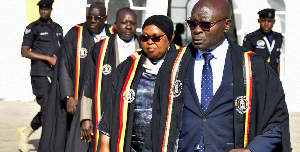The Alliance for a Green Revolution in Africa (AGRA) has started a dialogue with the National Aeronautics and Space Administration (NASA) to access data from their over-200 satellites that hover around the earth to provide critical information for smallholder farmers in Africa.
The ground-breaking process has already begun, with the first meeting taking place in Accra recently led by Molly E. Brown, a research scientist and geographer with the NASA Goddard Space Flight Centre in the United States, and Dr. Kwasi Ampofo, AGRA’S Country Head in Ghana.
A member of the AGRA negotiating team, Abdou Matieyedou Koniambique, told B&FT in an interview that the agricultural sector in Africa faces many challenges, and one of those is climate change.
Secondly, agriculture is going through a transformation geared toward a more business-oriented regimen that requires accurate, timely and informed decision-making to succeed.
“If a private investor decides to make investments he needs information to enable him/her plan better, and that is the essence of the collaboration AGRA seeks with NASA to provide real-time information about weather patterns, soil texture, etc — which NASA has data on through feedback from the satellites,” Abdou said.
Speaking to B&FT on the sidelines of the Accra meeting, Molly Brown said NASA has many satellites that go around the earth and look down on the ground.
“You can use this information to view trends — for instance, how this growing season is developing compared to let’s say 30 years ago, since the satellites collect data daily over places like Ghana and Kenya and other regions of the world.”
With this is information, farmers are in a better position to determine optimal planting seasons, and Ms. Brown’s job is to analyse these scientific data and provide them to organisations like AGRA for societal good.
She indicated that it is done at no cost to the consumer since NASA has a totally-free data policy.
She said she wrote a grant proposal to NASA to start this two-year project with AGRA.
The project began on June 11, 2014 and the objective is to develop software and hand it over to a Ghanaian software company that will transmit information like weather patterns and climate forecasting to farmers through SMS text messages.
Molly is hopeful that by 2016 the roll-out phase will have been completed and handed over to the Ghanaian software company to operate.
The local company, which was also present at the deliberations, is Image AD — an IT company that specialises in the integration of agricultural value chain actors through mobile phone and web applications.
The CEO, Kwame Bentil, told B&FT that by October this year the website will have been completed.
He said the meeting is to enable ImageAd determine what sought of data is coming from the satellites and how to use that data to inform farmers on the ground about weather patterns, rainfall and soil-moisture content.
He said by the end of the project, ImageAd should be able to establish an office to run the activities on its own.
The project will be piloted over a year with farmers linked to AGRA projects — since AGRA provides funding to organisations like ImageAd to provide services to farmers with the overall objective of increasing productivity.
Dr. Ampofo told B&FT that since AGRA’s objective is to trigger a green revolution in Africa that transforms agriculture into a highly competitive and sustainable system assuring food security and lifting millions out of poverty, they believe a partnership with NASA to provide timely information for farmers to make informed decisions — like applying weather information to plant maize or green peas in specific conditions — will improve farmers’ decision-making.
He was hopeful that groups like ImageAd can capture useful data from NASA and provide farmers with real-time information through mobile phones to make informed decisions.
To achieve the unique green revolution, AGRA has set its sights on achieving three major goals by 2020.
These are: reducing food insecurity by 50 percent in at least 20 sub-Saharan African countries; doubling incomes of at least 20 million smallholder farmers across the African continent; and moving at least 30 countries onto a sustainable path toward transforming their agricultural sectors.
AGRA is currently involved in 16 sub-Saharan African countries including Ghana.
Business News of Thursday, 7 August 2014
Source: B&FT
NASA to assist Ghana’s smallholder farmers
Entertainment












